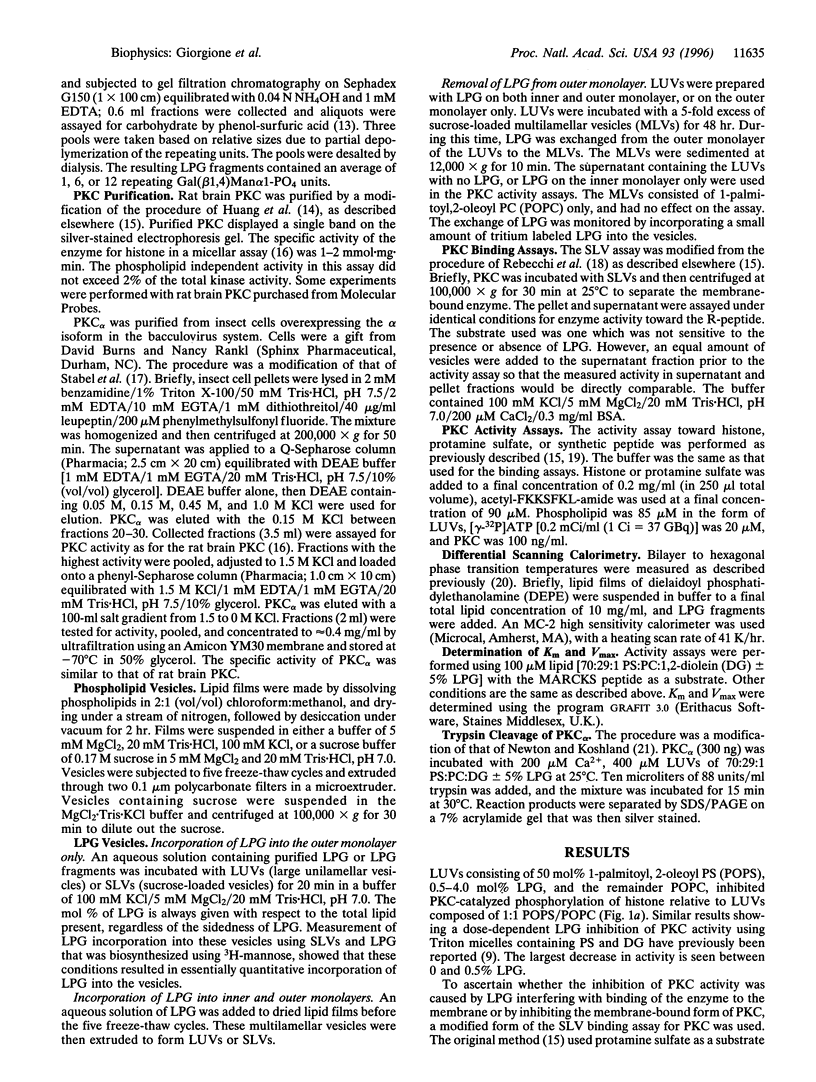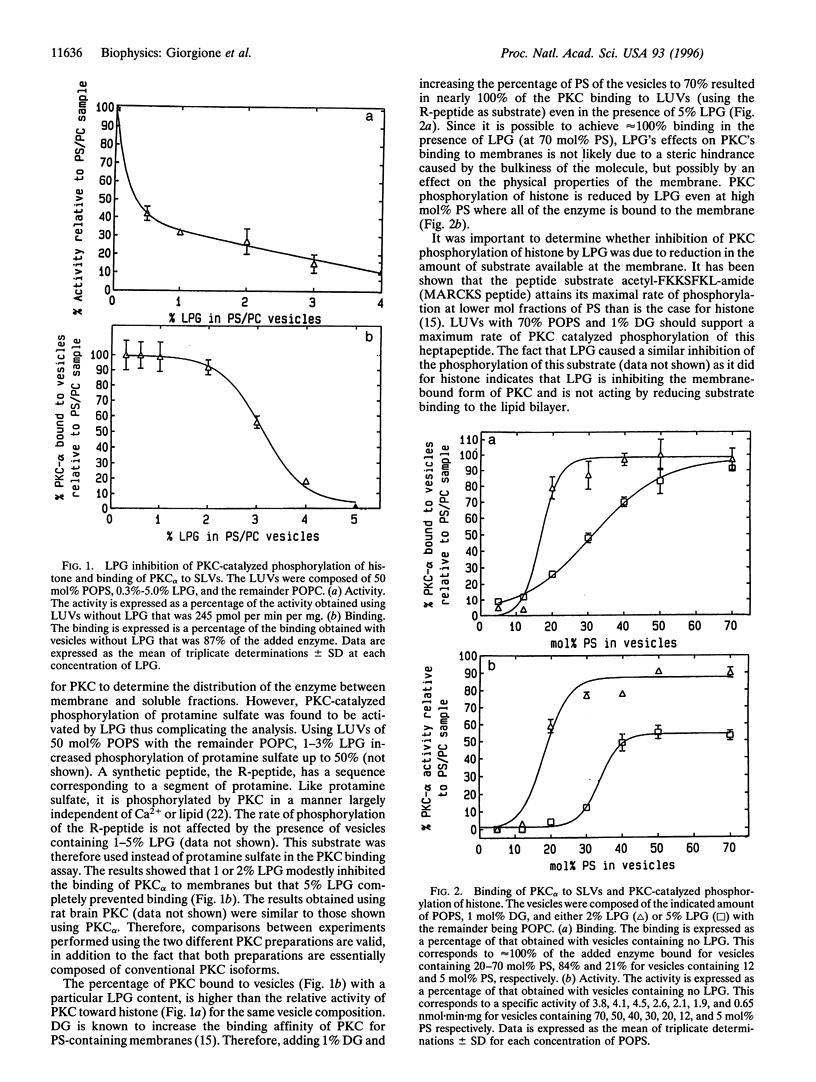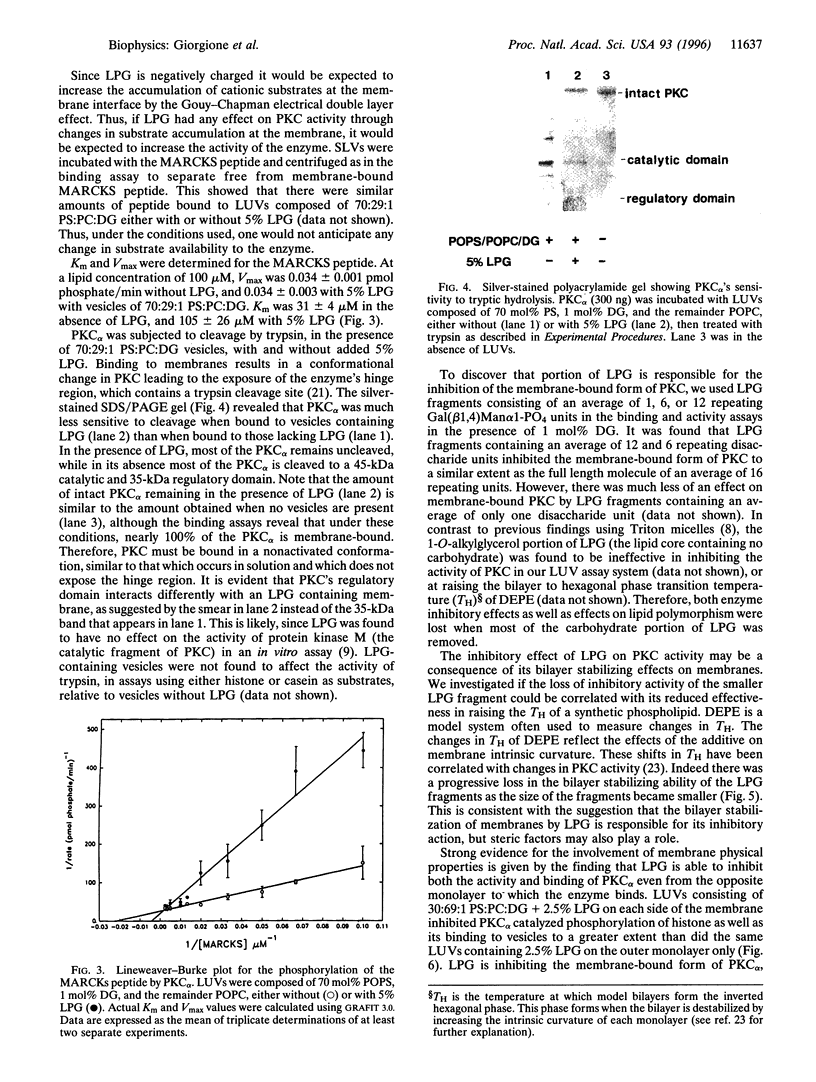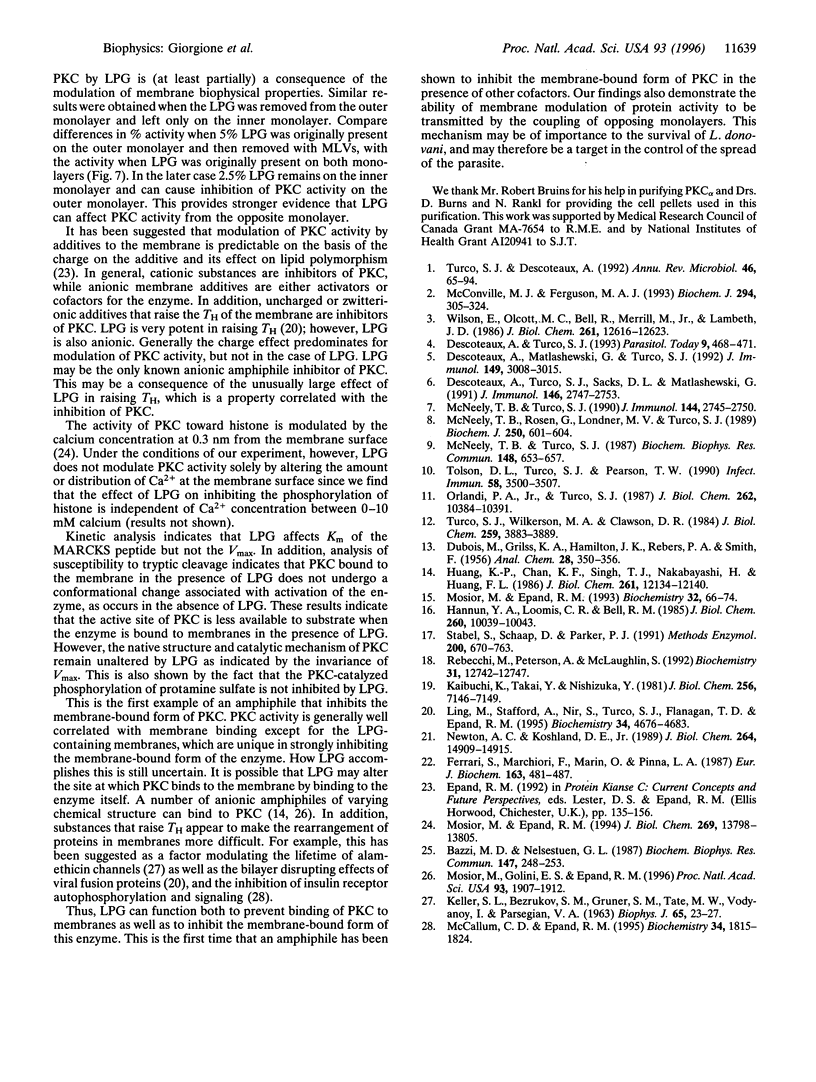Abstract
Lipophosphoglycan (LPG), the predominant molecule on the surface of the parasite Leishmania donovani, has previously been shown to be a potent inhibitor of protein kinase C (PKC) isolated from rat brain. The mechanism by which LPG inhibits PKC was further investigated in this study. LPG was found to inhibit the PKC alpha-catalyzed phosphorylation of histone in assays using large unilamellar vesicles composed of 1-palmitoyl, 2-oleoyl phosphatidylserine and 1-palmitoyl, 2-oleoyl phosphatidylcholine either with or without 1% 1,2 diolein added. The results also indicated that while PKC binding to sucrose-loaded vesicles was not substantially reduced in the presence of LPG at concentrations of 1-2%, the activity of membrane-bound PKC was inhibited by 70%. This inhibition of the membrane-bound form of PKC is not a consequence of reduced substrate availability to the membrane. However, Km shifted from approximately 31 +/- 4 microM to 105 +/- 26 microM in the presence of 5% LPG. LPG caused PKC to bind to membranes without inducing a conformational change as revealed by the lack of an increased susceptibility to trypsin. An LPG fragment containing only one repeating disaccharide unit was not as effective as the entire LPG molecule or of larger fragments in inhibiting the membrane-bound form of the enzyme. The shorter fragments were also less potent in raising the bilayer to hexagonal phase transition temperature of a model membrane. LPG is also able to inhibit the membrane-bound form of PKC alpha from the inner monolayer of large unilamellar vesicles, the opposite monolayer to which the enzyme binds in our assay. Inhibition is likely a result of alterations in the physical properties of the membrane. To our knowledge, this is the first example of a membrane additive that can inhibit the membrane-bound form of PKC in the presence of other lipid cofactors.
Full text
PDF





Images in this article
Selected References
These references are in PubMed. This may not be the complete list of references from this article.
- Bazzi M. D., Nelsestuen G. L. Substrate-specific stimulation of protein kinase C by polyvalent anion. Biochem Biophys Res Commun. 1987 Aug 31;147(1):248–253. doi: 10.1016/s0006-291x(87)80113-4. [DOI] [PubMed] [Google Scholar]
- Descoteaux A., Matlashewski G., Turco S. J. Inhibition of macrophage protein kinase C-mediated protein phosphorylation by Leishmania donovani lipophosphoglycan. J Immunol. 1992 Nov 1;149(9):3008–3015. [PubMed] [Google Scholar]
- Descoteaux A., Turco S. J., Sacks D. L., Matlashewski G. Leishmania donovani lipophosphoglycan selectively inhibits signal transduction in macrophages. J Immunol. 1991 Apr 15;146(8):2747–2753. [PubMed] [Google Scholar]
- Descoteaux A., Turco S. J. The lipophosphoglycan of Leishmania and macrophage protein kinase C. Parasitol Today. 1993 Dec;9(12):468–471. doi: 10.1016/0169-4758(93)90105-o. [DOI] [PubMed] [Google Scholar]
- Ferrari S., Marchiori F., Marin O., Pinna L. A. Ca2+ phospholipid-dependent and independent phosphorylation of synthetic peptide substrates by protein kinase C. Eur J Biochem. 1987 Mar 16;163(3):481–487. doi: 10.1111/j.1432-1033.1987.tb10894.x. [DOI] [PubMed] [Google Scholar]
- Hannun Y. A., Loomis C. R., Bell R. M. Activation of protein kinase C by Triton X-100 mixed micelles containing diacylglycerol and phosphatidylserine. J Biol Chem. 1985 Aug 25;260(18):10039–10043. [PubMed] [Google Scholar]
- Huang K. P., Chan K. F., Singh T. J., Nakabayashi H., Huang F. L. Autophosphorylation of rat brain Ca2+-activated and phospholipid-dependent protein kinase. J Biol Chem. 1986 Sep 15;261(26):12134–12140. [PubMed] [Google Scholar]
- Kaibuchi K., Takai Y., Nishizuka Y. Cooperative roles of various membrane phospholipids in the activation of calcium-activated, phospholipid-dependent protein kinase. J Biol Chem. 1981 Jul 25;256(14):7146–7149. [PubMed] [Google Scholar]
- Keller S. L., Bezrukov S. M., Gruner S. M., Tate M. W., Vodyanoy I., Parsegian V. A. Probability of alamethicin conductance states varies with nonlamellar tendency of bilayer phospholipids. Biophys J. 1993 Jul;65(1):23–27. doi: 10.1016/S0006-3495(93)81040-3. [DOI] [PMC free article] [PubMed] [Google Scholar]
- McCallum C. D., Epand R. M. Insulin receptor autophosphorylation and signaling is altered by modulation of membrane physical properties. Biochemistry. 1995 Feb 14;34(6):1815–1824. doi: 10.1021/bi00006a001. [DOI] [PubMed] [Google Scholar]
- McConville M. J., Ferguson M. A. The structure, biosynthesis and function of glycosylated phosphatidylinositols in the parasitic protozoa and higher eukaryotes. Biochem J. 1993 Sep 1;294(Pt 2):305–324. doi: 10.1042/bj2940305. [DOI] [PMC free article] [PubMed] [Google Scholar]
- McNeely T. B., Rosen G., Londner M. V., Turco S. J. Inhibitory effects on protein kinase C activity by lipophosphoglycan fragments and glycosylphosphatidylinositol antigens of the protozoan parasite Leishmania. Biochem J. 1989 Apr 15;259(2):601–604. doi: 10.1042/bj2590601. [DOI] [PMC free article] [PubMed] [Google Scholar]
- McNeely T. B., Turco S. J. Inhibition of protein kinase C activity by the Leishmania donovani lipophosphoglycan. Biochem Biophys Res Commun. 1987 Oct 29;148(2):653–657. doi: 10.1016/0006-291x(87)90926-0. [DOI] [PubMed] [Google Scholar]
- McNeely T. B., Turco S. J. Requirement of lipophosphoglycan for intracellular survival of Leishmania donovani within human monocytes. J Immunol. 1990 Apr 1;144(7):2745–2750. [PubMed] [Google Scholar]
- Miao L., Stafford A., Nir S., Turco S. J., Flanagan T. D., Epand R. M. Potent inhibition of viral fusion by the lipophosphoglycan of Leishmania donovani. Biochemistry. 1995 Apr 11;34(14):4676–4683. doi: 10.1021/bi00014a022. [DOI] [PubMed] [Google Scholar]
- Mosior M., Epand R. M. Characterization of the calcium-binding site that regulates association of protein kinase C with phospholipid bilayers. J Biol Chem. 1994 May 13;269(19):13798–13805. [PubMed] [Google Scholar]
- Mosior M., Epand R. M. Mechanism of activation of protein kinase C: roles of diolein and phosphatidylserine. Biochemistry. 1993 Jan 12;32(1):66–75. doi: 10.1021/bi00052a010. [DOI] [PubMed] [Google Scholar]
- Mosior M., Golini E. S., Epand R. M. Chemical specificity and physical properties of the lipid bilayer in the regulation of protein kinase C by anionic phospholipids: evidence for the lack of a specific binding site for phosphatidylserine. Proc Natl Acad Sci U S A. 1996 Mar 5;93(5):1907–1912. doi: 10.1073/pnas.93.5.1907. [DOI] [PMC free article] [PubMed] [Google Scholar]
- Newton A. C., Koshland D. E., Jr High cooperativity, specificity, and multiplicity in the protein kinase C-lipid interaction. J Biol Chem. 1989 Sep 5;264(25):14909–14915. [PubMed] [Google Scholar]
- Orlandi P. A., Jr, Turco S. J. Structure of the lipid moiety of the Leishmania donovani lipophosphoglycan. J Biol Chem. 1987 Jul 25;262(21):10384–10391. [PubMed] [Google Scholar]
- Rebecchi M., Peterson A., McLaughlin S. Phosphoinositide-specific phospholipase C-delta 1 binds with high affinity to phospholipid vesicles containing phosphatidylinositol 4,5-bisphosphate. Biochemistry. 1992 Dec 29;31(51):12742–12747. doi: 10.1021/bi00166a005. [DOI] [PubMed] [Google Scholar]
- Stabel S., Schaap D., Parker P. J. Expression of protein kinase C isotypes using baculovirus vectors. Methods Enzymol. 1991;200:670–673. doi: 10.1016/0076-6879(91)00179-z. [DOI] [PubMed] [Google Scholar]
- Tolson D. L., Turco S. J., Pearson T. W. Expression of a repeating phosphorylated disaccharide lipophosphoglycan epitope on the surface of macrophages infected with Leishmania donovani. Infect Immun. 1990 Nov;58(11):3500–3507. doi: 10.1128/iai.58.11.3500-3507.1990. [DOI] [PMC free article] [PubMed] [Google Scholar]
- Turco S. J., Descoteaux A. The lipophosphoglycan of Leishmania parasites. Annu Rev Microbiol. 1992;46:65–94. doi: 10.1146/annurev.mi.46.100192.000433. [DOI] [PubMed] [Google Scholar]
- Turco S. J., Wilkerson M. A., Clawson D. R. Expression of an unusual acidic glycoconjugate in Leishmania donovani. J Biol Chem. 1984 Mar 25;259(6):3883–3889. [PubMed] [Google Scholar]
- Wilson E., Olcott M. C., Bell R. M., Merrill A. H., Jr, Lambeth J. D. Inhibition of the oxidative burst in human neutrophils by sphingoid long-chain bases. Role of protein kinase C in activation of the burst. J Biol Chem. 1986 Sep 25;261(27):12616–12623. [PubMed] [Google Scholar]





